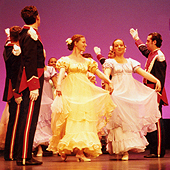
|
PolonezThe Polonez is the oldest Polish national dance and is still
performed today as the opening dance at many functions.
The music, in
particularly its rhythm, forces dancers to perform in a specific
style which on one side displays itself in dignity and
stateliness. Among nobility and the courts of the
Polish Kings, the Polonez was known as the Great Polish Dance. |
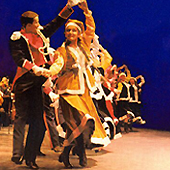
|
MazurThe most beautiful Polish national dance, is expressed
through a diversity of intricate dance steps. The rhythm of the Mazurka
is well known from the Mazurkas created by the famous Polish
composer Frederic Chopin to the Polish national anthem.
The two Mazur dances performed by Polonez are danced to the
music from the opera Haunted Manor (Straszny Dwor) and from the
opera Halka, written by Stanislaw Moniuszko. |
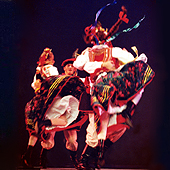
|
Krakow SuiteKrakow is well known not only as the site of the old capital of
Poland, but also as a vibrant center of rich folklore, historic
traditions, and arts and its folklore is widely regarded as the
most beautiful. As horses are loved
in this region, there is a familiar galloping step
prevalent in the dances. The men's costumes are of particular
interest with peacock feathers in their hats and strings of metal
rings at the belts; a historical reference to an ancient warrior's
outfit. A strange animal, the Turon, makes his appearance
bringing good luck. |
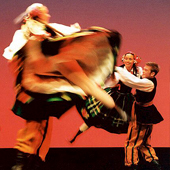
|
Lowicz SuiteA collection of dances from the region of Lowicz, Opoczno, and Kujawy,
located in central Poland. The beautiful and richly embroidered costumes
(from the Lowicz region) reflect the rich customs and romantic atmosphere prevalent
in the dances. The suite consists of quick Obereks and lyrical Kujawiaks. |
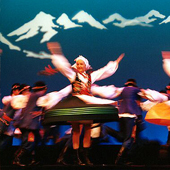
|
Pogorze and Rzeszow SuiteThis suite will showcase dances from the Pogorze region in
southeastern Poland. The music and dances of this region differ
altogether from other regions of Poland in that they are much
livelier, more dynamic, and carefree at the same time. There is a
wealth of dance steps unknown in other regions. Rzeszow polkas are different
from the rest of Poland and over one hundred of them have been
registered in this small corner of our country! Among others you
will see polka bez noge, polka dzwon, polka hura, wsciekla
polka... |
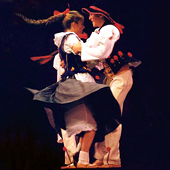
|
Beskid Slaski and Zywiecki SuiteShepherd's dances from the mountain region of Zywiec/Slask, which
is located in the south of Poland sharing the border with the Czech
Republic. The most popular dances of the Zywiec region include the
Kolomajki, which is well known for its liveliness and quick tempo
intertwined with singing, performed by girls alone. Characteristic
of the Slask region are solos for men (Hajduk) in which they display
their physical strength to the women. Kon, Siustany, Obyrtki, and
Sarna are seen in these dances. |
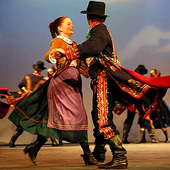
|
Lachy Sadeckie SuiteDances from this southern region of Poland are typically preceded
by short ditties setting the mood and pace. As in many mountain
dances, men want to show their prowess and courage by trying to
outdo one another. The suite consists of Szurok, Polka gwozdz,
Szarpok, Sztajer, Krzyzok, Polka z nogi, Cieta polka, Wsciekla
polka, and Krakowiaki sadeckie in which men display their
talent. |
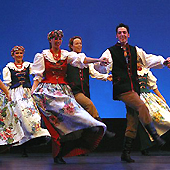
|
Slask SuiteThe Silesia region is situated in southwestern Poland. One of the
dances performed from this region include a Trojak, a unique dance
performed in triplets. There is also Polka Grozik, Waltz, and a very spirited
and dynamic dance Polka Trzesionka (Shaking polka). |
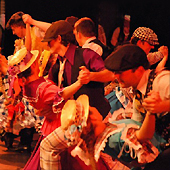
|
City SuiteA collection of polkas, a tango and waltz. These dances are the
popular dances of the working class of Krakow and Lwow,
representing turn-of-the-century city folklore. |